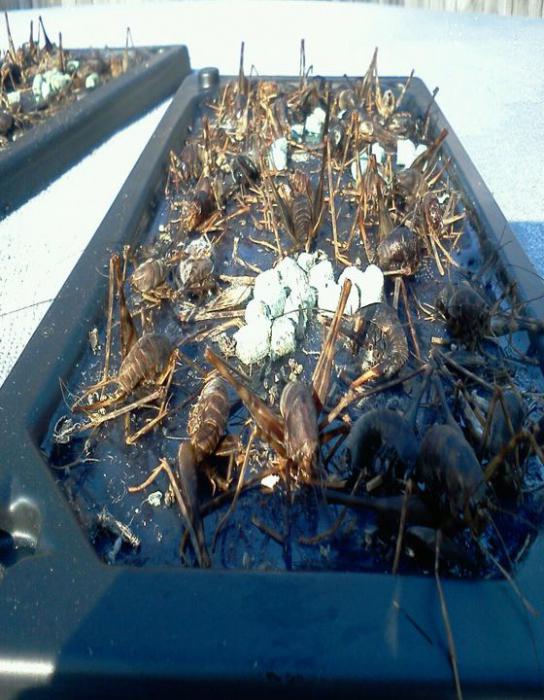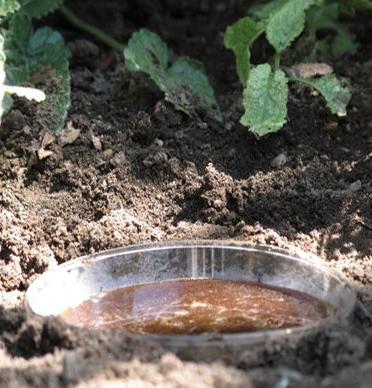One of the worst pests living in gardens and gardens is the bear. This insect is omnivorous - it eats young leaves of plants, and tender roots, and tubers, and bulbs. As a result, they wither and die. Seeing dying plants, gardeners and gardeners take active steps and try to make a trap for the bear to rid their plots of this pest. However, you can fight this insect not only with the help of traps. For the most effective protection of landings, it is important to know the peculiarities of the behavior and breeding of the bear, as well as various ways to combat it.
What is this "beast"?
Medvedka, scientifically called Gryllotalpa, is an insect that has a rather repulsive appearance. The length of its rigid body with wings varies from 5 to 7 cm. The chest shell of the insect is hard, and allows the head to partially hide under its protection. The bear’s head is “decorated” with strong horny jaws framed by two pairs of tentacles, two large compound eyes and a long antennae. The forelimbs of this insect are more developed, compared with the rest, and are designed to dig up passages underground. The head, chest and upper surface of the body of the insect are colored dark brown, and the abdomen and extremities are lighter, olive brown.
Medvedka prefers well-fertilized, especially manicured soils, and digs vertical passages in them, the depth of which can reach up to 100-120 centimeters. As a rule, such a move ends with a horizontal chamber in which adult insects overwinter. Larvae hibernate in vertical passages at a depth of 60-80 cm.
Why was she called the "bear"?
This pest got its name because of the awkward, profusely pubescent dark brown body. In addition, in some places, the bear is called "earthen cancer" because of the jagged serrated forelegs in the
form of ticks. For the special attention that this pest gives to young plants of cabbage, it is also called "cabbage", "cabbage". Young insect larvae have a gray color and a huge appetite, for which they were nicknamed "tops".
Why is it dangerous?
Medvedka gladly eats seeds sown in the ground, underground parts of garden crops such as tomatoes, cucumbers, various kinds of peppers and eggplant. Damaged by this insect, the plants dry out, and it is quite easy to pull them out of the garden. In crops such as potatoes, carrots and beets, the bear gnaws stems, eats roots and gnaws large cavities in root crops.
The fact that a bear wound up on the site is evidenced by small tubercles of soil formed from rolled lumps of earth.
Thinking over ways to deal with the bear, you should remember that this insect can move not only underground. This pest is able to swim pretty well in water, and also to fly considerable distances at night.
Birds do not pose a threat to this insect, as it leads a secretive lifestyle.
How to deal with a bear?
Thinking over ways to deal with the bear, it should be remembered that some one of them, even having the most positive reviews, is unlikely to help. In order to expel an insect from the site, a combination of several methods and tools will be required. And you need to conduct events not only in the spring-summer period, but also year-round, and for several years. In this fight, it is best to team up with the owners of neighboring sites to prevent the pest from moving to unprotected territory.
What are the methods of struggle?
All known methods of fighting a bear can be divided into several groups:
- chemical;
- mechanical;
- physical;
- biological.
But in order for the fight to be effective, first of all, you need to remove from the site everything that could be chosen by this insect. These are heaps of old debris and leaves, the remains of building materials and compost pits. Let us dwell in more detail on each of the options.
Chemicals
Today, many drugs are produced to combat the bear. These are quite powerful tools, but they are all very poisonous, and not only for the insect pest, but also for beneficial insects and microorganisms, as well as for poultry and animals. Most of these products are available in the form of granules that need to be buried in the soil during planting of seedlings or seeds, and then watered abundantly. The bear will find the soaked granules underground by smell and will definitely eat it. Only a garden treated in this way should not produce poultry.
Mechanical methods
Thinking how to get rid of the bear forever, you must first plan and conduct deep spring and autumn plowing of the garden. This will destroy the underground passages of the insect, destroy its larvae and make it as difficult as possible to get food.
In addition, throughout the growing season you need to carry out deep, up to 15 centimeters, loosening of plantings and row spacing. This will also greatly complicate the life of the bear and its offspring.
Physical methods
In order to protect seedlings planted in the soil, gardeners create various protective barriers around young plants. Someone uses nylon potato bags to protect the root system and rubber tubules for a gentle basal neck. Some use mulch from straw or tree bark. The soil under the mulching layer warms up much weaker, which does not allow the bear to arrange a nest under such beds.
The physical methods of killing pests include various types of traps. Consider the most affordable performance materials.
Warm Manure Traps

Knowing the characteristics of the insect, during the entire growing season, as well as in the autumn-winter period, you can destroy a large number of these pests. Such a trap for a bear can be arranged by any gardener who has ordinary cow or horse manure in reserve. For the arrangement, in addition to manure, you will need an old metal tank with a bottom. This can be an old tank, basin or bucket, which is deepened into the soil so that the top of the tank is 3-4 cm below the soil level. Manure and 1/3 of the volume of compost or humus are poured into it. From above, pour it all with sunflower oil with a “smell” or beer at the rate of 2-3 tablespoons per container. Such smells lure a bear, like the smell of valerian - a cat. Then the container is covered with cubes or slats, so that between them there are gaps sufficient for the "passing" of the bear, and covered with old slate, roofing material or a dark film, preventing the ingress of rainwater. Thus, a do-it-yourself trap for a bear is made. It can be left in late autumn and removed in the spring after the snow melts. You can also put a similar design in the spring and summer, removing it every 30-35 days.
After the trap for the bear was taken out of the soil, all the contents need to be burned by dumping it in a previously diluted fire or a metal container for burning garbage.
Shadow like a trap
Knowing that this pest insect loves dark but warm places, you can create a shadow trap for the bear. This will require old pieces of plywood, roofing felt or cardboard of a dark color, which will need to be laid out on the site. In order to make the bear more likely to trap, under the sheets make small indentations in which you can put steamed pearl barley, millet or rice porridge, seasoned with unrefined vegetable oil with a smell or beer. Such traps should be checked and destroyed the bear in them twice a day - in the morning, at 10-11 hours, and in the evening, at sunset. You need to approach shelters quietly, but you need to open and destroy insects quickly to prevent them from leaving.
Hop trap
As already mentioned, this insect is not indifferent to the smell of beer. If you know about this, then how to make a trap for a bear becomes simple and obvious. The cheapest beer is taken , but having the most pronounced beer smell, is poured 100 milliliters into 0.5 liter plastic bottles or wide-necked cans. For every one hundredth of a site, there must be at least two traps. Before installing containers with beer, you need to very well wet the soil with water - to a depth of at least 15 cm. In a prepared hole with a depth of about 6 cm, bottles or cans of beer are placed at an angle of 45 0 , the neck of which is covered with one layer of gauze. We cover the entire structure with any material that does not allow sunlight, and sprinkle the edges with earth, so that it is both warm and damp inside. Such traps should be checked weekly, destroying insects that got into them.

In addition to the methods listed above, you can get rid of the bear in folk ways: pour needles, needles or crushed eggshells into the hole, immediately before planting . Also, knowing the dislike of this insect for iodine, you can spill the beds prepared for planting plants with an aqueous solution of iodine at the rate of 15 drops per 10 liters of water.
Biological products
In addition to the fact that the bear has a negative attitude to the smell of iodine and its derivatives, she also does not like natural and pungent smells. Many gardeners note that marigolds (they are also sometimes called marigolds), as well as calendula against the bear, help quite effectively. When planting seedlings in the soil, you can put in the hole the dried flowers of these plants and several cloves of garlic, onion husks. Pungent odors will not interfere with plant growth, but they are unlikely to attract an insect, and it will bypass such plantings. You can decorate the beds with low grades of marigolds or calendula - both practical and beautiful!